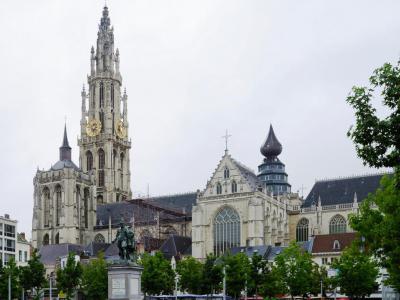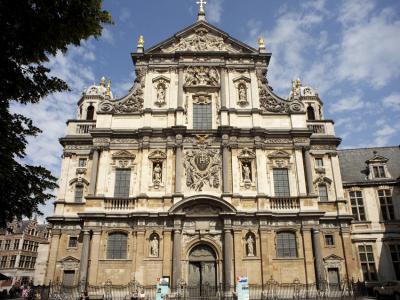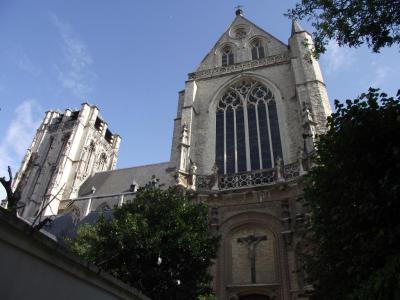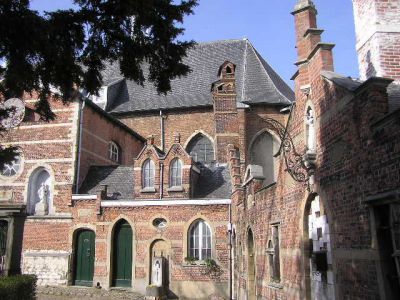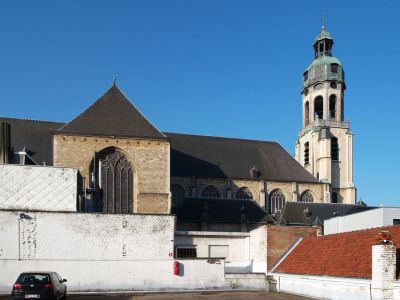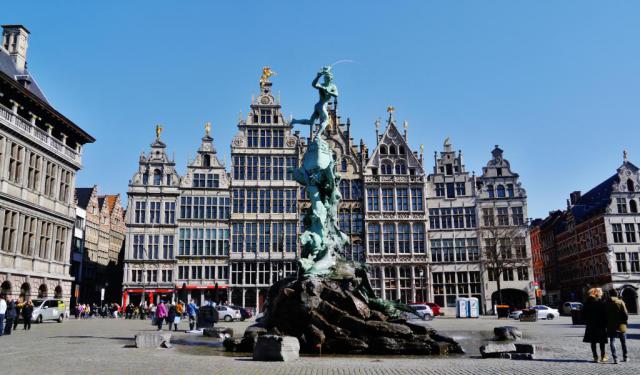Antwerp's Historical Churches Tour (Self Guided), Antwerp
Antwerp, a city steeped in history and culture, boasts an array of historical churches that stand as testaments to its past.
Reigning supreme among them is the Cathedral of Our Lady, a stunning 14th-century Gothic masterpiece. Its towering spire dominates the city skyline and houses invaluable artworks by renowned artists such as Peter Paul Rubens, Otto van Veen, Jacob de Backer, and Marten de Vos.
Saint Paul's Church, another architectural gem, showcases a mix of Gothic and Baroque splendor with its elaborate facade and ornate interior. This church, constructed from the 16th to the 17th centuries, is renowned for its magnificent marble sculptures and intricate stone- and woodcarvings.
The Church of Carolus Borromeus, a striking example of Baroque, is dedicated to the Jesuit saint Charles Borromeo. Its lavish interior features stunning frescoes and elaborate gilded decorations, offering visitors a glimpse into the grandeur of the Counter-Reformation era.
Saint James' Church, with its imposing bell tower and elegant facade, is a prominent landmark in Antwerp. Dating back to the 17th century, this church combines elements of Gothic and Baroque styles, making it a fascinating architectural marvel.
To feel the spirit of antiquity, head to the Beguinage of Antwerp. This tranquil 13th-century sanctuary, nestled within the bustling city, provides a glimpse into Antwerp's medieval past. A UNESCO World Heritage Site, it features charming cobblestone streets lined with picturesque cottages and a serene courtyard, offering visitors a peaceful retreat from the urban hustle.
Saint Andrew's Church, although less grandiose in scale, holds historical significance as one of Antwerp's oldest parishes, established in the 16th century. Its simple yet elegant design reflects the city's enduring religious heritage and serves as a reminder of its rich cultural legacy.
Exploring Antwerp's historical churches is an opportunity to appreciate the artistry, architecture, and spirituality that have shaped this vibrant city. So, take this self-guided walk to immerse yourself in the beauty and history of these sacred landmarks and discover the soul of Antwerp.
Reigning supreme among them is the Cathedral of Our Lady, a stunning 14th-century Gothic masterpiece. Its towering spire dominates the city skyline and houses invaluable artworks by renowned artists such as Peter Paul Rubens, Otto van Veen, Jacob de Backer, and Marten de Vos.
Saint Paul's Church, another architectural gem, showcases a mix of Gothic and Baroque splendor with its elaborate facade and ornate interior. This church, constructed from the 16th to the 17th centuries, is renowned for its magnificent marble sculptures and intricate stone- and woodcarvings.
The Church of Carolus Borromeus, a striking example of Baroque, is dedicated to the Jesuit saint Charles Borromeo. Its lavish interior features stunning frescoes and elaborate gilded decorations, offering visitors a glimpse into the grandeur of the Counter-Reformation era.
Saint James' Church, with its imposing bell tower and elegant facade, is a prominent landmark in Antwerp. Dating back to the 17th century, this church combines elements of Gothic and Baroque styles, making it a fascinating architectural marvel.
To feel the spirit of antiquity, head to the Beguinage of Antwerp. This tranquil 13th-century sanctuary, nestled within the bustling city, provides a glimpse into Antwerp's medieval past. A UNESCO World Heritage Site, it features charming cobblestone streets lined with picturesque cottages and a serene courtyard, offering visitors a peaceful retreat from the urban hustle.
Saint Andrew's Church, although less grandiose in scale, holds historical significance as one of Antwerp's oldest parishes, established in the 16th century. Its simple yet elegant design reflects the city's enduring religious heritage and serves as a reminder of its rich cultural legacy.
Exploring Antwerp's historical churches is an opportunity to appreciate the artistry, architecture, and spirituality that have shaped this vibrant city. So, take this self-guided walk to immerse yourself in the beauty and history of these sacred landmarks and discover the soul of Antwerp.
How it works: Download the app "GPSmyCity: Walks in 1K+ Cities" from Apple App Store or Google Play Store to your mobile phone or tablet. The app turns your mobile device into a personal tour guide and its built-in GPS navigation functions guide you from one tour stop to next. The app works offline, so no data plan is needed when traveling abroad.
Antwerp's Historical Churches Tour Map
Guide Name: Antwerp's Historical Churches Tour
Guide Location: Belgium » Antwerp (See other walking tours in Antwerp)
Guide Type: Self-guided Walking Tour (Sightseeing)
# of Attractions: 6
Tour Duration: 2 Hour(s)
Travel Distance: 3.6 Km or 2.2 Miles
Author: mary
Sight(s) Featured in This Guide:
Guide Location: Belgium » Antwerp (See other walking tours in Antwerp)
Guide Type: Self-guided Walking Tour (Sightseeing)
# of Attractions: 6
Tour Duration: 2 Hour(s)
Travel Distance: 3.6 Km or 2.2 Miles
Author: mary
Sight(s) Featured in This Guide:
- Cathedral of Our Lady
- Saint Paul's Church
- Church of Carolus Borromeus
- St. James' Church
- Beguinage
- St. Andrew's Church
1) Cathedral of Our Lady (must see)
Overlooking the city of Antwerp since the 14th century is the beautiful Cathedral of Our Lady, which till date dominates the city’s skyline. Built by architects Jan and Pieter Appelmans, the Cathedral boasts a magnificent Gothic structure with hints of Baroque style complementing the interiors of the building.
Whether you are a history buff or an admirer of architecture, the Cathedral of Our Lady is one structure that has something to offer every visitor. The structure stands as the epitome of the perfect combination of artistic architecture, breathtaking interiors and a dramatic past making it a tantalizing site to visit.
Although the construction of the structure began in 1352, it took more than a century to complete the entire construction. The Cathedral that stands today rests on the same site where once stood a small chapel dedicated to Our Lady. The chapel traced its history to early 10th century and it was subsequently followed by the construction of a Romanesque Church.
The Gothic Cathedral that took its place was considered one of the most magnificent structures of its time and one of the largest cathedrals in the whole of Benelux. However despite all its glories, the Cathedral of Our Lady has faced a very turbulent past. From natural fires to raids, plunders and assault by iconoclasts, the structure has born tremendous damage over the years. But it has stood the test of time and stands proudly today in the city of Antwerp.
Whether you are a history buff or an admirer of architecture, the Cathedral of Our Lady is one structure that has something to offer every visitor. The structure stands as the epitome of the perfect combination of artistic architecture, breathtaking interiors and a dramatic past making it a tantalizing site to visit.
Although the construction of the structure began in 1352, it took more than a century to complete the entire construction. The Cathedral that stands today rests on the same site where once stood a small chapel dedicated to Our Lady. The chapel traced its history to early 10th century and it was subsequently followed by the construction of a Romanesque Church.
The Gothic Cathedral that took its place was considered one of the most magnificent structures of its time and one of the largest cathedrals in the whole of Benelux. However despite all its glories, the Cathedral of Our Lady has faced a very turbulent past. From natural fires to raids, plunders and assault by iconoclasts, the structure has born tremendous damage over the years. But it has stood the test of time and stands proudly today in the city of Antwerp.
2) Saint Paul's Church
Saint Paul's Church in Antwerp is a remarkable architectural and artistic treasure combining Gothic and Baroque elements. Established in 1548 and completed in 1571, the church originally served the Our Lady of the Rosary fraternity. Its construction spans periods of religious and political turmoil, including Calvinist control in 1578, which led to the expulsion of the Dominicans and the repurposing of the church for secular uses such as cannon foundry.
The building was severely damaged during the siege of Antwerp in 1584 but was later reclaimed and refurbished by the Dominicans after 1585, including extensive Baroque renovations and rebuilding efforts that continued until 1662. A devastating fire in 1679 and subsequent French occupation in 1796 led to further changes and restoration, with the church enduring more damage during the Dutch bombardment of 1830 and another fire in 1968. Restoration efforts have been ongoing to preserve its rich historical legacy.
The church's exterior is defined by the Brabantine Gothic style, characterized by austere architecture with minimal decoration-a common feature in mendicant orders' churches. The tower, rebuilt in the late 17th century, features a Baroque top, and the Baroque portal from 1734 adds a significant historical layer.
The interior of the church is notable for its use of brick walls and Ledian sandstone for the structural components and is lavishly decorated in the Flemish Baroque style. It houses an impressive array of art by leading Antwerp artists such as Peter Paul Rubens, Anthony van Dyck, and Jacob Jordaens, among others. The church's interior also features extensive Baroque sculpture and church furniture crafted by prominent Antwerp sculptors like Artus Quellinus the Elder and Pieter Verbrugghen I.
A standout feature outside the church is the Calvary, an elaborate ensemble of 63 life-size statues and nine reliefs, depicting scenes in a dramatic and accessible style. Inside, the church boasts the most impressive collection of Baroque confessionals in Belgium, conceived as integral parts of the church's architecture, rather than mere pieces of furniture.
Saint Paul's Church not only serves as a place of worship but also as a museum of religious art and Baroque craftsmanship, reflecting the tumultuous history and rich cultural heritage of Antwerp.
The building was severely damaged during the siege of Antwerp in 1584 but was later reclaimed and refurbished by the Dominicans after 1585, including extensive Baroque renovations and rebuilding efforts that continued until 1662. A devastating fire in 1679 and subsequent French occupation in 1796 led to further changes and restoration, with the church enduring more damage during the Dutch bombardment of 1830 and another fire in 1968. Restoration efforts have been ongoing to preserve its rich historical legacy.
The church's exterior is defined by the Brabantine Gothic style, characterized by austere architecture with minimal decoration-a common feature in mendicant orders' churches. The tower, rebuilt in the late 17th century, features a Baroque top, and the Baroque portal from 1734 adds a significant historical layer.
The interior of the church is notable for its use of brick walls and Ledian sandstone for the structural components and is lavishly decorated in the Flemish Baroque style. It houses an impressive array of art by leading Antwerp artists such as Peter Paul Rubens, Anthony van Dyck, and Jacob Jordaens, among others. The church's interior also features extensive Baroque sculpture and church furniture crafted by prominent Antwerp sculptors like Artus Quellinus the Elder and Pieter Verbrugghen I.
A standout feature outside the church is the Calvary, an elaborate ensemble of 63 life-size statues and nine reliefs, depicting scenes in a dramatic and accessible style. Inside, the church boasts the most impressive collection of Baroque confessionals in Belgium, conceived as integral parts of the church's architecture, rather than mere pieces of furniture.
Saint Paul's Church not only serves as a place of worship but also as a museum of religious art and Baroque craftsmanship, reflecting the tumultuous history and rich cultural heritage of Antwerp.
3) Church of Carolus Borromeus
The Spanish invasion of 1584 brought in a wave of forced Catholicism to Antwerp. Protestants either left the city or were converted to Catholicism. The Jesuits decided to counter this reformation and François d'Aguilon, a Jesuit mathematician began work on a Baroque styled church. Similar to the Chiesa del Gesù in Rome, this new church in Antwerp was completed in 1621 and was called the Ignatius Church. Much of the interiors including many ceiling paintings were completed by the local artist, P.P.Rubens. A unique feature of the Church is the mechanism to change the painting at the altar.
The Fire of 1718 destroyed most of Rubens’ work but the mechanism to change paintings survives to this day. The structure became a Parish Church in 1803 when it was given its current name. Today, it stands neatly tucked away behind some modern buildings at the Hendrik Conscience Square. Several protests during the 1960s and 70s have made this area a pedestrian zone which gives the area its instantly appreciated serenity. During your walk to the Church you might come across the soothing notes of violin being played to make your visit very special. We request you to please check the open hours of the Church before visiting. The Artist’s mass on Sundays and other holidays should not be missed.
The Fire of 1718 destroyed most of Rubens’ work but the mechanism to change paintings survives to this day. The structure became a Parish Church in 1803 when it was given its current name. Today, it stands neatly tucked away behind some modern buildings at the Hendrik Conscience Square. Several protests during the 1960s and 70s have made this area a pedestrian zone which gives the area its instantly appreciated serenity. During your walk to the Church you might come across the soothing notes of violin being played to make your visit very special. We request you to please check the open hours of the Church before visiting. The Artist’s mass on Sundays and other holidays should not be missed.
4) St. James' Church
Saint James' Church in Antwerp is a historical architectural gem renowned for its Brabantine Gothic style. Originally established on the site of a hostel for pilgrims heading to Santiago de Compostela, the church began as a chapel in 1431, serving as a pivotal stop for those on their way to the burial place of Saint James the Great. The chapel was transformed into a parish church in 1476 to meet expanding religious and communal demands, leading to the construction of a larger building in 1491. Although it took 165 years to finish, the church retained its Gothic style, even though Baroque architecture became popular by its completion in 1656.
The interior of Saint James' Church is adorned in Baroque style, a transformation largely preserved due to the strategic actions of a priest during the French revolutionary invasion, saving it from plunder. The church houses exquisite Baroque elements such as the intricately carved wooden choir stalls, the lavish main altar, and the finely crafted communion rails. The central pulpit, completed in 1675 by Lodewijk Willemsens, adds to the church’s rich Baroque character.
Saint James' Church also played an important musical role; its organs attracted numerous renowned musicians, including Henry Bredemers. The grand organ, built in 1884 by Anneesens in a Romantic style, and the choir organ from 1727 by J.B. Forceville, still maintain their original mechanical action.
The church is notably the final resting place of several of Antwerp's elite, including the illustrious painter Peter Paul Rubens, whose tomb features a painting by Rubens himself, completed five years posthumously in 1640. Today, Saint James' Church stands as a monument to Antwerp's historical, artistic, and architectural heritage, attracting visitors not only for its religious significance but also for its cultural and historical riches, preserving over 1300 graves and the memories of more than 4500 individuals.
The interior of Saint James' Church is adorned in Baroque style, a transformation largely preserved due to the strategic actions of a priest during the French revolutionary invasion, saving it from plunder. The church houses exquisite Baroque elements such as the intricately carved wooden choir stalls, the lavish main altar, and the finely crafted communion rails. The central pulpit, completed in 1675 by Lodewijk Willemsens, adds to the church’s rich Baroque character.
Saint James' Church also played an important musical role; its organs attracted numerous renowned musicians, including Henry Bredemers. The grand organ, built in 1884 by Anneesens in a Romantic style, and the choir organ from 1727 by J.B. Forceville, still maintain their original mechanical action.
The church is notably the final resting place of several of Antwerp's elite, including the illustrious painter Peter Paul Rubens, whose tomb features a painting by Rubens himself, completed five years posthumously in 1640. Today, Saint James' Church stands as a monument to Antwerp's historical, artistic, and architectural heritage, attracting visitors not only for its religious significance but also for its cultural and historical riches, preserving over 1300 graves and the memories of more than 4500 individuals.
5) Beguinage
Antwerp is filled with historical and architectural delights, some quite prominent while others that go unnoticed by many and the Beguinage is one such historical site.
Secluded from the relatively urban area, the Beguinage is a welcoming sight for those who admire vintage architecture and love history. Enclosed within tall, bricked, windowless walls, the clustered housing complex of the 16th century transports its visitor to the medieval era. Today these isolated structures, reminisce the tale of the land and keep alive the memory of the much forgotten Beguines.
The Beguines were a group of religious women who followed the disciplined lives of the nuns without taking a formal oath or vow. However, unlike nuns, a Beguine had the freedom to leave the institution whenever she liked. This was a very popular cult during the 12th century especially amongst the Low Countries, which includes modern day countries of Belgium, Netherlands, parts of Germany and France.
The Beguinage in Antwerp was founded around 1240 and was situated outside the walls of the city. Due to constant attacks by plunderers, the Beguinage was shifted within the city limits of Antwerp. Today, all the Beguinages around the world are preserved as ‘Heritage Site’s by the UNESCO.
Secluded from the relatively urban area, the Beguinage is a welcoming sight for those who admire vintage architecture and love history. Enclosed within tall, bricked, windowless walls, the clustered housing complex of the 16th century transports its visitor to the medieval era. Today these isolated structures, reminisce the tale of the land and keep alive the memory of the much forgotten Beguines.
The Beguines were a group of religious women who followed the disciplined lives of the nuns without taking a formal oath or vow. However, unlike nuns, a Beguine had the freedom to leave the institution whenever she liked. This was a very popular cult during the 12th century especially amongst the Low Countries, which includes modern day countries of Belgium, Netherlands, parts of Germany and France.
The Beguinage in Antwerp was founded around 1240 and was situated outside the walls of the city. Due to constant attacks by plunderers, the Beguinage was shifted within the city limits of Antwerp. Today, all the Beguinages around the world are preserved as ‘Heritage Site’s by the UNESCO.
6) St. Andrew's Church
Saint Andrew's Church in Antwerp is a Catholic parish church known for its rich historical tapestry and architectural beauty, bridging late-Gothic exteriors with a Baroque interior. The church's foundation dates back to the 16th century, beginning with Augustine friars who established a convent and chapel on the site in 1513. The transition to a parish church occurred in 1529 after a tumultuous period involving accusations against the Augustinians of Lutheran sympathies, which led to their loss of the grounds.
The church's early history is marked by adversity, notably during the Beeldenstorm of 1566 when its interiors were ravaged, and subsequent periods of division and reconstruction amidst religious conflicts between Catholics and Calvinists. It was only after the Fall of Antwerp in 1585 that the church returned to Catholic hands, ushering in a new era of decoration by prominent Antwerp artists such as Otto van Veen and members of the Francken family.
The 17th century saw major expansions and renovations to the church, such as a new Baroque tower in 1755 after the original collapsed. This period also added Baroque furniture and artwork from other churches affected by the French Revolution. Despite damage from the Dutch bombardment in 1830 and WWII, the church continued to be restored, including replacing destroyed stained glass windows with new designs to preserve its historical essence.
Inside, Saint Andrew’s houses an array of important religious artifacts and artworks, including a monument to Mary, Queen of Scots, and works by revered painters like Hendrick van Balen and Anthony van Dyck. Its furniture is notably Baroque, crafted by renowned sculptors such as Willem Kerricx, reflecting the artistic wealth amassed after the Beeldenstorm.
Saint Andrew's Church remains a testament to the resilience and cultural heritage of Antwerp, continually adapting and flourishing through each chapter of its storied past.
The church's early history is marked by adversity, notably during the Beeldenstorm of 1566 when its interiors were ravaged, and subsequent periods of division and reconstruction amidst religious conflicts between Catholics and Calvinists. It was only after the Fall of Antwerp in 1585 that the church returned to Catholic hands, ushering in a new era of decoration by prominent Antwerp artists such as Otto van Veen and members of the Francken family.
The 17th century saw major expansions and renovations to the church, such as a new Baroque tower in 1755 after the original collapsed. This period also added Baroque furniture and artwork from other churches affected by the French Revolution. Despite damage from the Dutch bombardment in 1830 and WWII, the church continued to be restored, including replacing destroyed stained glass windows with new designs to preserve its historical essence.
Inside, Saint Andrew’s houses an array of important religious artifacts and artworks, including a monument to Mary, Queen of Scots, and works by revered painters like Hendrick van Balen and Anthony van Dyck. Its furniture is notably Baroque, crafted by renowned sculptors such as Willem Kerricx, reflecting the artistic wealth amassed after the Beeldenstorm.
Saint Andrew's Church remains a testament to the resilience and cultural heritage of Antwerp, continually adapting and flourishing through each chapter of its storied past.
Walking Tours in Antwerp, Belgium
Create Your Own Walk in Antwerp
Creating your own self-guided walk in Antwerp is easy and fun. Choose the city attractions that you want to see and a walk route map will be created just for you. You can even set your hotel as the start point of the walk.
Antwerp Introduction Walking Tour
A major city-port on the River Scheldt in Belgium, Antwerp is known primarily as the diamond capital of Europe. For centuries, Antwerp's Diamond District has been the center of diamond trade, with thousands of dealers, cutters and polishers processing 85% of the world's rough diamonds each year.
Historical Antwerp has its origins in a Gallo-Roman settlement, first mentioned in the 4th... view more
Tour Duration: 2 Hour(s)
Travel Distance: 3.5 Km or 2.2 Miles
Historical Antwerp has its origins in a Gallo-Roman settlement, first mentioned in the 4th... view more
Tour Duration: 2 Hour(s)
Travel Distance: 3.5 Km or 2.2 Miles
Antwerp Historic Center Walk
Antwerp is a bustling metropolis, replete with modern entertainment, yet it is the centuries-old city center that fuels tourists' interest the most. Indeed, downtown Antwerp is steeped in history. So much so, in fact, that to see all that it has to offer, you'll need way more than one day.
Here history awaits you practically round every corner – seen in the ancient building-fronts... view more
Tour Duration: 2 Hour(s)
Travel Distance: 3.9 Km or 2.4 Miles
Here history awaits you practically round every corner – seen in the ancient building-fronts... view more
Tour Duration: 2 Hour(s)
Travel Distance: 3.9 Km or 2.4 Miles
The Most Popular Cities
/ view all



